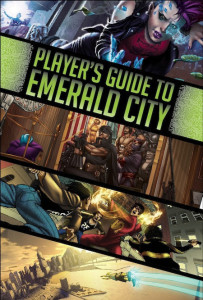

What does a gamer do when her gaming buddies invite her into an established Mutants & Masterminds game, something she’s never had a chance to play? Go shopping for More Gaming Goodies, of course! (Right after saying, “Oh, yes! Please!”) And M&M 3rd Edition’s Player’s Guide to Emerald City (Green Ronin Publishing) is one fantastic goody!
Emerald City, located somewhere on the Northwest US coast, is one of the major game settings for M&M, a place where superheroes and villains are a new phenomenon.The Player’s Guide is available as a PDF for $10. It is also part of the campaign setting book, Emerald City ($59.95 hardcover/$29.95 PDF). The setting book also includes a full-color map, the GM’s guide Secrets of Emerald City and the adventure book Emerald City Knights, each also offered as an individual PDF*. If you are not planning to GM M&M, you don’t need the whole kit and caboodle, just this book and the Core book. Bonus HeroLab files (for the pre-gen characters in the final chapter) are also included for players and GMs who use the software.
The 91 page sourcebook is engaging from the start. The introductory overview is a Tourist’s Guide that is written and styled like the ones real-life tourism boards publish. There are many sidebars that are as fun as they are useful, scattered through the book, but mostly in Chapter 2. The “Ghost Sightings” blogs contain adventure hooks, for example. Even better are sidebars focusing on mechanics for genre tropes. Does your PC have enough Strength ranks to throw – or catch – a city bus? Need a few handy tips and powers for stopping a speeding locomotive? There are sidebars for these and many other super-tropes.
Chapter 1, “Emerald City History,” does a great job of mixing real history with the fictional setting. There is enough information on local World War II “mystery men” heroes and events to run a campaign set in that era (or time travel!), rather than the default post-Silver Storm setting. Many actual WWII events – from Axis subs off the US coasts to the forced removal and internment of the Nisei – are used in respectful fashion to make the fictional history realistic. The nineteenth, remainder of the twentieth & twenty-first centuries get similar, if less in-depth, treatment. I suspect some of the omitted information is in the GM materials, from the way some things read. I cannot confirm because I have resisted the temptation to get hold of and read those. So far.
Chapters 2 and 3, “The City & Surrounds” and “Life in Emerald City” are also good reads plus very useful to players who want details for their character’s backstory or need an answer when the GM opens the session with, “It’s Saturday afternoon, where are you and what’s everyone doing?” GMs can also find plenty of venues and innocent bystanders for a super-powered incident or not-so-natural disaster. Locations aren’t limited to the cliched college labs and big businesses with odd/secret agendas. There are Asian enclaves, shopping districts, a “happening” LGBT nightclub and not nearly as many pro sports teams as the locals think they deserve. The colleges and businesses aren’t left out either; there are several of both, so heroes of every socio-economic class can find a place to study at, work for, or harbor suspicions about. One of my fellow players used this book, particularly these 2 chapters, to help me with my new PC’s backstory, and it was so helpful and interesting that I had to have my own copy to see what else was in there besides an orchestra (my PC is a harpist in her secret ID) and a hospital that was starting a program to treat supers (her doctor boyfriend’s new specialty).
The last two chapters, “The Emerald City Series” and “Emerald City Heroes,” I didn’t find quite as interesting even though they are as detailed as the other four. I felt most of the material covered was aimed more at GMs than players. “Series” covers Complications for teams as a whole, versus for individual PCs, and campaign settings and power levels other than the defaults. I can see why they were included here, since the GM would need player buy-in if planning such a campaign or to help an undecided group figure out what kind of game experience they wanted. The other chapter material is possible origins for PCs besides Stormer, the commonest one in the setting. These alternate origins are not very detailed, no doubt to avoid spoilers; several of them refer players to their GM’s copy of Secrets of Emerald City, which is a good way to handle this balance. “Heroes,” as you might guess, are ready-to-play PCs, members of the Sentinels team, to get the game underway faster. GM sidebars cover using them instead as an NPC team, solo NPC heroes or villains, so “Heroes” is a good resource even for campaigns where players prefer to create their own PCs.
Player’s Guide to Emerald City is my kind of game book. It has lots of good information and you will enjoy reading it because it has the same sense many good SF/fantasy novels have, that this is a real place. Fitting into an existing campaign, with established PCs and their shared history, can be difficult, even if you are familiar with the system (which I wasn’t). Getting this sourcebook made it a lot easier on me – even if my PC has had problems in-character. It’s not only fun, it is useful fun at a very good price. For gamers like me who are on a budget – and even Max Mars would have trouble affording my gaming wishlist – this is as good as it gets.
*Only the full Emerald City set is available in both hardcover and PDF formats.
Linda Whitson
Latest posts by Linda Whitson (see all)
- Astral Projections – The Ripperdoc Is In - May 8, 2023
